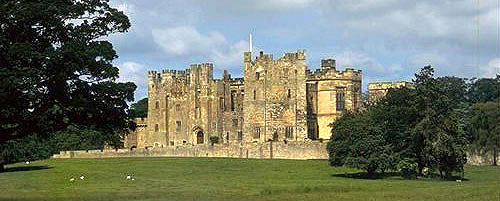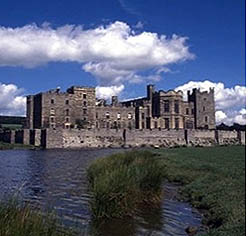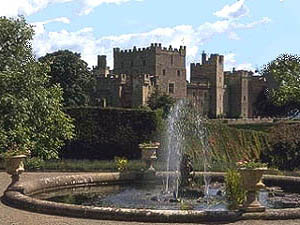Raby Castle and the Rising of the North
by Dr. Gareth Evans
Set in a 200 acre deer park, some eighteen miles south west of Durham, Raby Castle is widely regarded as one of the grandest of its kind, having some of the most outstanding examples of medieval, Regency and Victorian architecture and interiors in the whole of England.

With an eventful history stretching back to the 11th Century and housing important collections of Meissen porcelain, tapestries, furnishings and paintings by Munnings, De Hooch, Teniers, Van Dyck and Reynolds, Raby is a top ranking destination on any tour of the region.
Early History
In the early 11th Century, the lands were owned by the Viking King Cnut (Canute the Great) and this Norse connection is reflected in the name Raby -- from 'Ra' meaning a boundary and 'Bi', a settlement. It has been suggested that Cnut, the self-styled 'Emperor of the North', may have built on the site and certainly some of the extant architecture dates from this around this period.
The present building was begun in c.1360 by John, 3rd Baron Nevill and in 1378 the Bishop of Durham duly granted a licence to crenellate. The Nevills were the most powerful family in the north at the time -- contemporarily styled "the makers of Kings" -- and the Castle reflects their prestige, power and soaring ambition.
John held a variety of honours before his death in 1388, including the Governorship of Aquitaine, 1378-81, and Lord Warden of the Marches.
Royal Connections
John was succeeded by his son, Ralph, who is mentioned in Shakespeare's Henry V. Ralph further advanced the family's standing, being made Earl of Westmoreland in 1397 -- the first to hold this title -- as well as Earl of Richmond, a Knight of the Garter and Earl Marshal of England. He fathered a total of twenty-one children, seven by his first wife, Lady Margaret Stafford, and fourteen by his second, Lady Joan Beaufort, who was the daughter of John of Gaunt. The youngest of these, Cicely, the "Rose of Raby", was to establish the family's Royal connection in no uncertain manner. She married Richard, Duke of York, was the mother of Edward IV and Richard III and her granddaughter, Elizabeth of York, became Henry VII's Queen.
Ralph died in 1425 and his alabaster tomb which stands in the nearby St Mary's Church, with effigies showing the Earl flanked by his two wives, is renowned as one of the finest monuments in northern England.
The Rising of the North
The Nevill family continued to enjoy significant influence in the Kingdom throughout most of the next 150 years, playing important roles in many of the major events of their time. The 3rd Earl fought against Perkin Warbeck; the 4th Earl battled the Scots, attended the Field of the Cloth of Gold, and was a signatory to the letter petitioning Pope Clement VII for the annulment of Henry VIII's marriage to Catherine of Aragon; as a boy, the 5th Earl took part in the Pilgrimage of Grace.
However, the family's star was about to be eclipsed and it was Henry VIII's break with Rome that was ultimately to signal the end of nearly four hundred years of Nevill power and influence.
 Staunch Catholics, the 5th Earl had been a steadfast supporter of Mary Tudor and held high office during her reign. However, as his successor, his son Charles was to face a difficult dilemma. With Mary's protestant half-sister Elizabeth on the throne, the 6th Earl found himself forced to choose between loyalty to his monarch or to his religion. His eventual decision -- to join Thomas Percy in leading the 1569 rebellion in support of the Catholic Mary, Queen of Scots -- sealed the Nevill fate. But the "Rising of the North" ultimately foundered and Charles fled to the Netherlands, where he died in abject poverty, thirty-two years later.
Staunch Catholics, the 5th Earl had been a steadfast supporter of Mary Tudor and held high office during her reign. However, as his successor, his son Charles was to face a difficult dilemma. With Mary's protestant half-sister Elizabeth on the throne, the 6th Earl found himself forced to choose between loyalty to his monarch or to his religion. His eventual decision -- to join Thomas Percy in leading the 1569 rebellion in support of the Catholic Mary, Queen of Scots -- sealed the Nevill fate. But the "Rising of the North" ultimately foundered and Charles fled to the Netherlands, where he died in abject poverty, thirty-two years later.
After the failed rebellion, the entire Estate was forfeited and remained in Crown ownership until 1626 when it was purchased by Sir Henry Vane the Elder, who was a Member of Parliament and prominent in Charles I's household. The Vanes were originally descended from Hywel ap Fane of Monmouthshire (the Welsh 'f' being pronounced like an English letter 'v') and remain the Castle's owners to this day. By one of those curious quirks of fate, the current owner Harry John Neville Vane, 11th Lord Barnard, is himself a direct descendant of the Nevills of Raby, through his grandmother.
The Civil War
Both Raby Castle and the Vanes played roles in the English Civil War. Henry the Elder opposed the King's execution and though he continued to sit in Parliament after Charles's death, he took little further part in active government, largely as a result of disagreements over Cromwell's polices. His son, Henry the Younger, who had become a Protestant Dissenter in his youth, was prominent in the Civil War itself but, like his father, he also became increasingly unhappy with the later course of the revolution. His opposition to Charles I's execution led to persecution under Cromwell and the restoration of the monarchy, when it came, was to bring him no respite. In 1662, he was charged with treason, sentenced and publicly beheaded, King Charles II having described him as "too dangerous a man to let live".
Although styled a "castle", Raby was always more a fortified home than military fortress. Never-the-less, it did see its share of action during the Civil War, when it was held for the Parliamentary forces by Sir George Vane. Twice besieged by the Royalists, first in 1645 and then again in 1648, the castle survived almost unscathed, Sir Henry the Elder repairing what little damage was inflicted.
The Architecture
Most of the actual castle building itself dates from the 14th Century, though its present day surroundings are the result of major alterations made during the 18th Century, when the moat was drained, the parkland landscaped, ornamental lakes excavated and the garden established.
Bulmer's Tower is the earliest, and certainly the most unusual, architectural feature to be seen, located at the south east corner of the building. Named after Bertram de Bulmer, a Norman Knight, the base of this pentagonal structure dates from the 11th Century and hints again at the possible Viking origins of the site, since the only other tower of similar design is in Denmark.
 The exterior of the Castle holds many other facets of historical note. There are examples of early leaded windows and archers' loops to be seen and beyond the battlements of the 14th Century Gatehouse, which once guarded the moat and drawbridge, stands Clifford's Tower, which retains some Edward III windows in its 10-ft thick solid walls. Standing next to Joan's Tower on the west side of the castle, the Nevill Gate forms the principal entrance-way and to this day, its overhead defensive machicolations and battering-ram scarred door bear witness to a history of violent contest.
The exterior of the Castle holds many other facets of historical note. There are examples of early leaded windows and archers' loops to be seen and beyond the battlements of the 14th Century Gatehouse, which once guarded the moat and drawbridge, stands Clifford's Tower, which retains some Edward III windows in its 10-ft thick solid walls. Standing next to Joan's Tower on the west side of the castle, the Nevill Gate forms the principal entrance-way and to this day, its overhead defensive machicolations and battering-ram scarred door bear witness to a history of violent contest.
The south face, which overlooks the lakes, is the most altered from its original state, the architect William Burn having built an impressive extension to an existing round tower in the 19th Century.
While externally the Castle has remained largely unchanged, three successive phases of interior renovation and rebuilding took place in the 18th and 19th Centuries within the building, though even here, some of the earlier features still remain. Much of the magnificent Barons' Hall, where the plotters of 1569 assembled, can be seen today, along with what has been called England's "grandest medieval kitchen" virtually unchanged since 1360 and the thick-walled Garrison Room, home to armed men (and their horses!) in times of trouble.
Renovation, Restoration and Repair
Having survived so long unaltered despite war and revolution, it is perhaps ironic that the first major repair work was needed not as a result of an enemy without, but the owner within. In 1714, Sir Christopher Vane, who had been elevated to the Peerage as the 1st Baron Barnard some sixteen years earlier, stripped the Castle of furniture, glass, metals, doors and woodwork in a fit of temper -- his son, Gilbert, having married in defiance of his wishes. Son sued father, and the Baron was forced to make good the damage.
However, the first phase of planned renovation began with Henry, the 3rd Lord Barnard and Earl of Darlington, who engaged the architect James Paine. The major changes to the southern and western interior of the Castle were made at this time. In 1768, his son Henry, the 2nd Earl Darlington, embarked on the second stage of the improvements which included the construction of the Gothic vaulting of the Entrance Hall and a round tower to replace one which was destroyed by fire earlier in the century.
Few further changes were made at the Castle until 1843, when William Burn was commissioned for the third period of rebuilding. Over the next ten years, Burn worked at Raby -- his greatest achievement of the time being the conversion of the new round tower built by John Carr during the preceding Century into the magnificent Octagon Drawing Room. In 1993, this room itself underwent a programme of extensive restoration that took five years to complete; it can now be seen, returned to how it would have looked at the time it was first built.
The Castle as it appears today has been little altered since some further additions were made by the 9th Lord Barnard in the late 19th Century.
Raby's Treasures
A variety of works of art are on display, spanning the 17th Century to more modern times, notable inclusions being The Circumcision of Christ and The Adoration of the Magi, by Luca Giordano, and A Group of Musicians, which has been attributed to Veronese. In addition, there are works by David Teniers the Younger, Sir Alfred Munnings, Pieter De Hooch, Anthony Van Dyck, J. E. Herring, I.M. Cohen, Thomas Barker, Hussey, Marco and Sebastiano Ricci, Amigoni and Cornelis de Vos. There is also an extensive collection of family portraits, including one of the ill-fated Charles Nevill.
The treasures of Raby are as eclectic as they are contrasting. Victorian copper cooking utensils sit in the 14th Century kitchen; the library holds multi-tiered 18th century porcelain Chinese pagodas of the Ch'ien Lung period; large Meissen birds, originally made around 1730 for the Japanese Palace in Dresden, grace the Baron's Hall. The collection also includes a marble statue by the American sculptor Hiram Powers shown at the Great Exhibition of 1851, a French Ormolu clock, bought at the Paris Exhibition in 1861, George IV furniture, 17th Century Flemish tapestry and a Queen Anne bookcase. Outside, in the 18th Century stables, there is a collection of carriages.
St Mary's Church in the village of Staindrop, was once the family church of the Nevills and, in addition to Earl Ralph's tomb, contains a number of other monuments covering many generations. The church is worth a visit in itself, being originally Saxon, with the later addition of a tower in the 12th Century and the south aisle, porch and nave all dating from the 15th-century.
Location
Raby Castle is in County Durham, in the North East of England. The main entrance is well sign-posted and accessed from the A688, on the northern outskirts of the village of Staindrop, approximately 18 miles south west of the City of Durham. For more information, visit the Raby Castle website at http://www.rabycastle.com/.
Related Articles:
- Barnard Castle: Stronghold of the North, by Dr. Gareth Evans
- https://www.timetravel-britain.com/articles/castles/barnard.shtml
- The Bowes Museum, by Alasdair Carter
- https://www.timetravel-britain.com/articles/museums/bowes.shtml
More Information:
We regret that we no longer have the resources to maintain up-to-date links and/or hours and pricing details for the various sites and attractions listed on this website. For more information about the location(s) listed above, please use your favorite search engine or visit Wikipedia.
Gareth Evans is a freelance writer and photographer, having previously worked in the private sector before lecturing at the University of Durham. Having travelled extensively, he now concentrates on writing about subjects much closer to home -- both geographically and metaphorically. He is particularly interested in myths, legends and folklore, together with the often forgotten history of the Celtic lands, especially that of his own native Wales and Scotland, his adopted home. Gareth is currently planning his next book, looking at the role of the pagan Horned God in myth and history.
Article and photos © 2005 Gareth Evans
|
